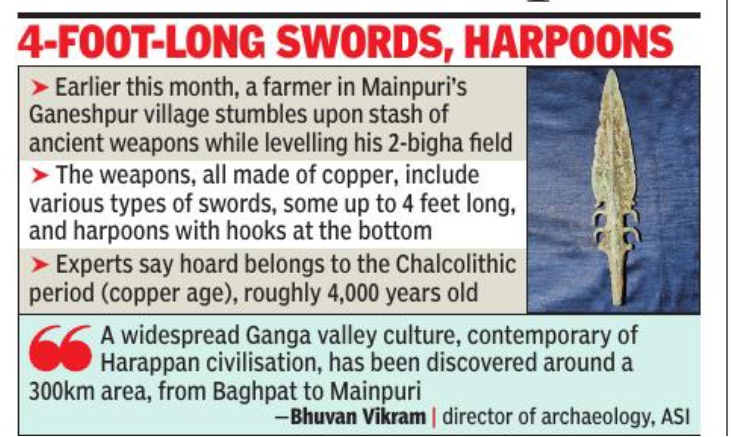Ganeshpur (Mainpuri)
This is a collection of articles archived for the excellence of their content. |
Archaeology
2022
Anuja Jaiswal, June 24, 2022: The Times of India

From: Anuja Jaiswal, June 24, 2022: The Times of India
Agra:They had big weapons, used large swords — some close to 4 feet long — and arms that had sharp, sophisticated shapes, like starfish. Our ancestors, nearly 4,000 years ago, fought brutally and hard, a chance discovery under the ground in UP's Mainpuri seems to suggest. Archaeologists have called the findings “exciting”.
Earlier this month in Mainpuri’s Ganeshpur village, a farmer was levelling his twobigha field when he found a large number of copper swords and harpoons beneath the soil. He took all of them home as he thought these were precious objects made of gold or silver. However, some locals informed cops and the Archaeological Survey of India (ASI) swung into action.
Among what was found were various swords, some that archaeologists are calling “antenna swords and harpoons'”, with a hook at the bottom.
Details
Anuja Jaiswal, June 24, 2022: The Times of India
Experts say a hoard of 4,000-year-old copper weapons discovered by chance under a field in Uttar Pradesh’s Mainpuri can be traced to the copper age.
“These copper hoards belong to the Chalcolithic period (copper age) and the presence of Ochre Coloured Pottery (OCP) is directly associated with this time,” said the director of archaeology at ASI, Bhuvan Vikram. “Bronze was a specialty of the Harappan — basically an urban civilisation during the copper age — but studies have revealed that such hoard implements were primarily made from copper and not bronze,” he added.
OCP culture is generally dated between 2,000 and 1,500 BCE. Pottery of this period had a red slip but gave off an ochre colour on the fingers of the archaeologists who touched it, hence the name. Director of conservation and spokesperson of ASI, Vasant Swarnkar, said there have been several discoveries that can prove the material found at Mainpuri was nearly 3,800-4,000 years old. “A carbon dating test was also carried out on samples taken from nearby Sanauli (Baghpat), Madarpur (Moradabad), and Sakatpur (Saharanpur) sites. They have proven to be from 2,000 BC (4,000 years ago),” he said.
“The presence of weapons indicates the people of this age were involved in fighting and that could be between two large groups for land or rights. These weapons couldn’t have been held by the common man,” he added. Superintending archaeologist Raj Kumar Patel told TOI it was a “chance discovery”. Vikram, who was involved in the excavations in Sakatpur village of Saharanpur district, said, “What needs to be explored is why the weapons were found in a cluster. Were the arms being transported or were they being made there?"
Historian and archaeologist at AMU, professor Manvendra Pundhir, said it seemed these arms “either belonged to warriors for fights between large groups or were used for hunting”. “However, earlier excavations in Sanauli found a ‘war chariot’, which supports the warrior theory. The findings reveal that war was common during the copper agebut this needs to be researched even more. ”